

Malaria vaccine shows early promise in clinical trials. 8 August 2013Last updated at 14:34 ET By Rebecca Morelle Science reporter, BBC World Service Living but weakened forms of the parasites were used in the new vaccine A malaria vaccine has shown promising results in early stage clinical trials, according to researchers.
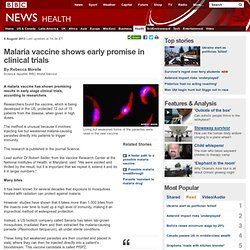
Researchers found the vaccine, which is being developed in the US, protected 12 out of 15 patients from the disease, when given in high doses. The method is unusual because it involves injecting live but weakened malaria-causing parasites directly into patients to trigger immunity. The research is published in the journal Science. 'Rivers' in air could boost flooding. 25 July 2013Last updated at 10:16 ET By David Shukman Science editor, BBC News The flooding in Cockermouth in 2009 was caused by one such atmospheric river Winter floods could intensify in Britain, according to new research into powerful weather systems called "atmospheric rivers".

Only identified about 20 years ago, atmospheric rivers are intense bands of moisture that flow through the air. Known to be responsible for heavy rainfall, they have been blamed for severe flooding in California and the UK. How to put a human on Mars. 24 July 2013Last updated at 03:39 ET Continue reading the main story This content is best viewed with Javascript enabled.

Visit BBC Webwise for full instructions. Neutrino 'flavour' flip confirmed. 19 July 2013Last updated at 08:33 ET By Jonathan Amos Science correspondent, BBC News Super-K looks for the faint flashes of light emitted when passing neutrinos interact with its water An important new discovery has been made in Japan about neutrinos.
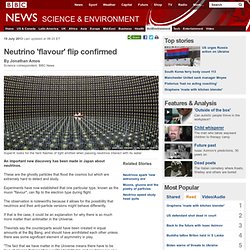
These are the ghostly particles that flood the cosmos but which are extremely hard to detect and study. Pioneering adult stem cell trial approved by Japan. 19 July 2013Last updated at 06:28 ET By James Gallagher Health and science reporter, BBC News The first trial of stem cells produced from a patient's own body has been approved by the Japanese government.
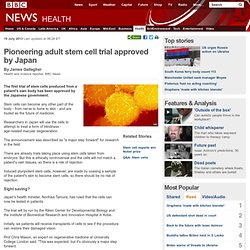
Stem cells can become any other part of the body - from nerve to bone to skin - and are touted as the future of medicine. Researchers in Japan will use the cells to attempt to treat a form of blindness - age-related macular degeneration. Yitang Zhang Proves 'Landmark' Theorem in Distribution of Prime Numbers. On April 17, a paper arrived in the inbox of Annals of Mathematics, one of the discipline’s preeminent journals.
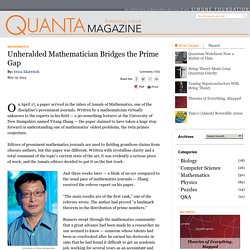
Written by a mathematician virtually unknown to the experts in his field — a 50-something lecturer at the University of New Hampshire named Yitang Zhang — the paper claimed to have taken a huge step forward in understanding one of mathematics’ oldest problems, the twin primes conjecture. The Hardest Thing To Find In The Universe? : Krulwich Wonders... What is rarer than a shooting star?

Rarer than a diamond? Rarer than any metal, any mineral, so rare that if you scan the entire earth, all six million billion billion kilos or 13,000,000,000,000,000,000,000,000 pounds of our planet, you would find only one ounce of it? What is so rare it has never been seen directly, because if you could get enough of it together, it would self-vaporize from its own radioactive heat? What is this stuff that can't be seen or found? Scientists outsmart dangerous bacteria using infrared light. The pesky bacterium Staphylococcus aureus (S. aureus), best known for causing staph infections such as MRSA, ranges dramatically in form.

In fact, recent studies indicate that S. aureus performs an efficient little microevolution to adapt to its host, so that it can evade the immune system and even survive antibiotics. Not to be outdone by the seeming intelligence of the bacterium, scientists at the University of Veterinary Medicine Vienna say they have devised a technique using infrared light to distinguish between strains of S. aureus that can cause chronic infections and those that cannot. They report their findings in the Journal of Clinical Microbiology. Speedy tsunami seen on Sun's surface.
17 July 2013Last updated at 12:27 ET By Jason Palmer Science and technology reporter, BBC News The false-colour footage shows waves of ultraviolet light from hot "plasma" Two satellites have seen "tsunami" spreading on the surface of the Sun after a release of matter into space called a coronal mass ejection (CME).
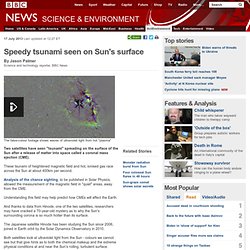
These tsunami of heightened magnetic field and hot, ionised gas race across the Sun at about 400km per second. Analysis of the chance sighting, to be published in Solar Physics, allowed the measurement of the magnetic field in "quiet" areas, away from the CME. Scientist believe humans 'may grow beaks instead of teeth like pufferfish' Scientists claim that longer life expectancy and modern diets make a limited supply of human teeth impracticalAre investigating a theory that humans will eventually evolve beyond teeth to grow a beak like a pufferfish which are 'far more robust and practical'Humans could grow an endless supply of teeth in the future By Fiona Macrae Published: 10:35 GMT, 3 July 2013 | Updated: 15:06 GMT, 5 July 2013 Scientists have been examining the jaws of pufferfish, which over millions of years have evolved special beaks to crack open crab shells and munch on crunchy food.
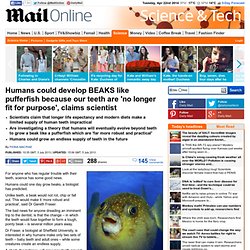
One theory that is being investigated suggests that humans will eventually evolve beyond teeth and grow our own beaks For anyone who has regular trouble with their teeth, science has some good news. Humans could one day grow beaks, a biologist has predicted. Unlike teeth, a beak would not rot, chip or fall out.
UK joins project to create synthetic organism from scratch. Scientists building the world's first synthetic yeast. How E. coli cells work in the human gut. (Phys.org) -- The bacterium Escherichia coli, commonly known as E. coli, has a duplicitous reputation. Scientists tell us that most strains of the microbe live peacefully in our guts or the guts of other mammals, munching on bits of food, causing no harm or even creating benefits for their hosts. But the grotesque imagery of E. coli infections tells a different story: After eating food contaminated with pathogenic strains, people can experience vomiting, diarrhea, and dysentery.
And in rare cases, the bacteria can lead to kidney failure and even death. Ken Campellone, assistant professor of molecular and cell biology in the College of Liberal Arts and Sciences, wants to understand how these bacteria can play such different roles. By focusing on the interactions between one of the deadliest E. coli strains and the cells of the human gut, he’s learning not only how the bacteria works, but how our own cells work, too. Explore further: Antibiotic resistance enzyme caught in the act. Afterlife: Making Rotten Food Beautiful. True Color Of An Exoplanet Discovered For The First Time. Looks a bit like Earth, doesn't it? You wouldn't find this planet very comfortable, however. Called HD 189773b, it's 1,000 degrees Celsius on its surface and it rains glass. Sideways. HD 189773b looks like Earth because it's blue.
Astronomers have determined its true color, a first for an exoplanet, or a planet orbiting a star other than Earth's own sun. Using data from the Hubble Space Telescope, a team of European and American astronomers measured the light reflection off of the exoplanet. Planet with four suns discovered. 15 October 2012Last updated at 11:33 ET By Paul Rincon Science editor, BBC News website The new planet - a gas giant - is about six times the size of Earth. Can science explain why I'm a pessimist? 9 July 2013Last updated at 21:02 ET. Being bilingual 'boosts brain power'
1 May 2012Last updated at 02:49 ET. Optical lattice atomic clock could 'redefine the second' 9 July 2013Last updated at 21:29 ET By Rebecca Morelle Science reporter, BBC World Service. Viewpoints: What does the future of IVF look like? 7 July 2013Last updated at 19:56 ET. Print me some skin. WASHINGTON, DC: At the annual meeting of the American Association for the Advancement of Science (AAAS) in Washington D.C., U.S. researchers described a process by which skin grafts can be printed using standard ink-jet cartridges. Study: plants 'talk' via funghi to warn about impending dangers.
A study has found that plants talk to one another when under attack via the symbiotic funghi mycorrhizae. Networks of mycorrhizae cover the roots of most plants, using their larger underground surface area to gather up more water and nutrients that the plant roots could possibly gather alone. The hidden power of moss. Sea urchin nickel 'trick' could be key to capturing carbon. 4 February 2013Last updated at 21:57 ET By Matt McGrath Environment correspondent, BBC News. New idea tackles Earth core puzzle. Scientists Detect Antimatter Particles in Solar Flares. Researchers from the United States and Russia analyzing microwave and magnetic-field data from solar-dedicated facilities and spacecraft have reported the first detection of positrons in solar flares.
NASA’s SOHO spacecraft captured this image of a solar flare as it erupted from the Sun on October 28, 2003 (NASA / SOHO) Associated with solar magnetic storms, solar flares are giant explosions on the Sun that send energy, light and particles into space. Mathematicians Shed Light on Minimalist Conjecture. In the fifth century B.C., a Greek mathematician made a discovery that shattered the foundations of mathematics and, according to legend, cost him his life.